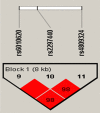Analysis of difference of association between polymorphisms in the XRCC5, RPA3 and RTEL1 genes and glioma, astrocytoma and glioblastoma
- PMID: 26328260
- PMCID: PMC4548341
Analysis of difference of association between polymorphisms in the XRCC5, RPA3 and RTEL1 genes and glioma, astrocytoma and glioblastoma
Abstract
Background: Gliomas are the most common aggressive brain tumors and have many complex pathological types. Previous reports have discovered that genetic mutations are associated with the risk of glioma. However, it is unclear whether uniform genetic mutations exist difference between glioma and its two pathological types in the Han Chinese population.
Materials and methods: We evaluated 20 SNPs of 703 glioma cases (338 astrocytoma cases, 122 glioblastoma cases) and 635 controls in a Han Chinese population using χ(2) test and genetic model analysis.
Results: In three case-control studies, we found rs9288516 in XRCC5 gene showed a decreased risk of glioma (OR, 0.85; 95% CI, 0.73-0.99; P = 0.042) and glioblastoma (OR, 0.70; 95% CI, 0.52-0.92; P = 0.001) in the allele model. We identified rs414805 in RPA3 gene showed an increased risk of glioblastoma in allele model (OR, 1.38; 95% CI, 1.00-1.89; P = 0.047) and dominant model (OR, 1.57; 95% CI, 1.05-2.35; P = 0.027), analysis respectively. Meanwhile, rs2297440 in RTEL1 gene showed an increased risk of glioma (OR, 1.30; 95% CI, 1.10-1.54; P = 0.002) and astrocytoma (OR, 1.26; 95% CI, 1.02-1.54; P = 0.029) in the allele model. In addition, we also observed a haplotype of "GCT" in the RTEL1 gene with an increased risk of astrocytoma (P = 0.005).
Conclusions: Polymorphisms in the XRCC5, RPA3 and RTEL1 genes, combinating with previous reaserches, are associated with glioma developing. However, those genes mutations may play different roles in the glioma, astrocytoma and glioblastoma, respectively.
Keywords: RPA3; RTEL1; XRCC5; astrocytoma; case-control study; glioblastoma; glioma.
Figures
Similar articles
-
RTEL1 tagging SNPs and haplotypes were associated with glioma development.Diagn Pathol. 2013 May 17;8:83. doi: 10.1186/1746-1596-8-83. Diagn Pathol. 2013. PMID: 23683922 Free PMC article.
-
The relationship between polymorphisms of XRCC5 genes with astrocytoma prognosis in the Han Chinese population.Oncotarget. 2016 Dec 20;7(51):85283-85290. doi: 10.18632/oncotarget.13297. Oncotarget. 2016. PMID: 27852033 Free PMC article.
-
TP53 and RPA3 gene variations were associated with risk of glioma in a Chinese Han population.Cancer Biother Radiopharm. 2013 Apr;28(3):248-53. doi: 10.1089/cbr.2012.1291. Cancer Biother Radiopharm. 2013. PMID: 23573956
-
The role of the RTEL1 rs2297440 polymorphism in the risk of glioma development: a meta-analysis.Neurol Sci. 2016 Jul;37(7):1023-31. doi: 10.1007/s10072-016-2531-z. Epub 2016 Mar 3. Neurol Sci. 2016. PMID: 26939676 Review.
-
[OMICS and biomarkers of glial tumors].Rev Neurol (Paris). 2011 Oct;167(10):691-8. doi: 10.1016/j.neurol.2011.07.007. Epub 2011 Sep 1. Rev Neurol (Paris). 2011. PMID: 21889780 Review. French.
Cited by
-
XRCC5/6 polymorphisms and their interactions with smoking, alcohol consumption, and sleep satisfaction in breast cancer risk: A Chinese multi-center study.Cancer Med. 2021 Apr;10(8):2752-2762. doi: 10.1002/cam4.3847. Epub 2021 Mar 18. Cancer Med. 2021. PMID: 33734613 Free PMC article.
-
RTEL1 gene polymorphisms and neuroblastoma risk in Chinese children.BMC Cancer. 2023 Nov 24;23(1):1145. doi: 10.1186/s12885-023-11642-3. BMC Cancer. 2023. PMID: 38001404 Free PMC article.
-
Impact of ANXA5 polymorphisms on glioma risk and patient prognosis.J Neurooncol. 2019 Mar;142(1):11-26. doi: 10.1007/s11060-018-03069-9. Epub 2018 Dec 7. J Neurooncol. 2019. PMID: 30536196
-
Clinical and Molecular Heterogeneity of RTEL1 Deficiency.Front Immunol. 2017 May 1;8:449. doi: 10.3389/fimmu.2017.00449. eCollection 2017. Front Immunol. 2017. PMID: 28507545 Free PMC article.
-
LPP and RYR2 Gene Polymorphisms Correlate with the Risk and the Prognosis of Astrocytoma.J Mol Neurosci. 2019 Dec;69(4):628-635. doi: 10.1007/s12031-019-01391-z. Epub 2019 Aug 23. J Mol Neurosci. 2019. PMID: 31440994
References
-
- Schwartzbaum JA, Fisher JL, Aldape KD, Wrensch M. Epidemiology and molecular pathology of glioma. Nat Clin Pract Neurol. 2006;2:494–503. quiz 1 p following 16. - PubMed
-
- Radner H, Blumcke I, Reifenberger G, Wiestler OD. [The new WHO classification of tumors of the nervous system 2000. Pathology and genetics] . Der Pathologe. 2002;23:260–83. - PubMed
-
- Wen PY, Kesari S. Malignant gliomas in adults. N Engl J Med. 2008;359:492–507. - PubMed
-
- Bondy ML, Scheurer ME, Malmer B, Barnholtz-Sloan JS, Davis FG, Il’yasova D, Kruchko C, McCarthy BJ, Rajaraman P, Schwartzbaum JA, Sadetzki S, Schlehofer B, Tihan T, Wiemels JL, Wrensch M, Buffler PA Brain Tumor Epidemiology Consortium. Brain tumor epidemiology: consensus from the Brain Tumor Epidemiology Consortium. Cancer. 2008;113:1953–68. - PMC - PubMed
LinkOut - more resources
Full Text Sources
Research Materials
Miscellaneous

